The Spatio-Temporal Cloud Frequency Distribution in the Galapagos Archipelago as Seen from MODIS Cloud Mask Data
Abstract
1. Introduction
2. Data & Methods
2.1. Study Area
2.2. MODIS Cloud Mask Data
2.3. Terrain Data
2.4. Data Processing
2.5. Cloud Frequency Analysis
2.6. Cloud Frequency Analysis along Elevation and Aspect
2.7. Cloud Frequency Analysis in Extreme Events
3. Results
3.1. Spatial and Diurnal Distribution of Cloud Frequency
3.2. Seasonal Distribution of Cloud Frequency
3.3. Cloud Frequency Analysis in Extreme Events
4. Discussion
4.1. Spatial and Diurnal Variations in Cloud Frequency
4.2. Seasonal Differences
4.3. Extreme Events
4.4. Uncertainties in Data and Method
5. Conclusions
- The cloud frequency reaches its maximum in the highlands, while it decreases abruptly in the uplands, due to the inversion layer;
- The windward, south-eastern slopes are more often covered by clouds than the leeward, north-western slopes. This is caused by the south-eastern trade winds;
- Diurnal differences in cloud frequency vary spatially, but the general cloud frequency over the islands is lower in the evening than in the morning;
- During the hot season, the cloud frequency over the islands is higher and more evenly distributed than during the cool season, both in the evening and the morning;
- The distribution of cloud frequency is more dependent on terrain altitude than on aspect during the hot season, while the opposite is true during the cool season;
- During El Niño 2015, the leeward sides, as well as the uplands, showed an increase in cloud coverage. Therefore, spatial differences in cloud frequency were less pronounced;
- La Niña 2007 had the opposite effect of El Niño 2015. The cloud frequency of the leeward sides and the upland areas showed a decreased cloud frequency. The cloud frequency over the ocean increased.
Supplementary Materials
Author Contributions
Funding
Institutional Review Board Statement
Informed Consent Statement
Data Availability Statement
Acknowledgments
Conflicts of Interest
Abbreviations
| ASTER | Advanced Spaceborne Thermal Emission and Reflection Radiometer |
| AVHRR | Advanced Very High Resolution Radiometer |
| ENSO | El Niño Southern Oscillation |
| ITCZ | Inter-Tropical Convergence Zone |
| MODIS | Moderate Resolution Imaging Spectrometer |
| NASA | National Aeronautics and Space Administration |
| ONI | Oceanic Niño Index |
| QA | Quality Assurance |
| SST | Sea Surface Temperature |
References
- Escobar-Camacho, D.; Rosero, P.; Castrejón, M.; Mena, C.F.; Cuesta, F. Oceanic islands and climate: Using a multi-criteria model of drivers of change to select key conservation areas in Galapagos. Reg. Environ. Chang. 2021, 21, 47. [Google Scholar] [CrossRef]
- Hobday, A.J.; Pecl, G.T. Identification of global marine hotspots: Sentinels for change and vanguards for adaptation action. Rev. Fish Biol. Fish. 2014, 24, 415–425. [Google Scholar] [CrossRef]
- Paltán, H.A.; Benitez, F.L.; Rosero, P.; Escobar-Camacho, D.; Cuesta, F.; Mena, C.F. Climate and sea surface trends in the Galapagos Islands. Sci. Rep. 2021, 11, 14465. [Google Scholar] [CrossRef]
- Dueñas, A.; Jiménez-Uzcátegui, G.; Bosker, T. The effects of climate change on wildlife biodiversity of the galapagos islands. Clim. Change Ecol. 2021, 2, 100026. [Google Scholar] [CrossRef]
- IPCC. Contribution of Working Group I to the Sixth Assessment Report of the Intergovernmental Panel on Climate Change; Cambridge University Press: Cambridge, UK, 2021.
- An, N.; Wang, K.; Zhou, C.; Pinker, R.T. Observed variability of cloud frequency and cloud-base height within 3600 m above the surface over the contiguous United States. J. Clim. 2017, 30, 3725–3742. [Google Scholar] [CrossRef]
- Ramanathan, V.; Cess, R.D.; Harrison, E.F.; Minnis, P.; Barkstrom, B.R.; Ahmad, E.; Hartmann, D. Cloud-Radiative Forcing and Climate: Results from the Earth Radiation Budget Experiment. Science 1989, 243, 57–63. [Google Scholar] [CrossRef]
- Stocker, T.F.; Qin, D.; Plattner, G.K.; Alexander, L.V.; Allen, S.K.; Bindoff, N.L.; Bréon, F.M.; Church, J.A.; Cubasch, U.; Emori, S.; et al. Climate change 2013: The physical science basis. Contribution of Working Group I to the Fifth Assessment Report of the Intergovernmental Panel on Climate Change, Technical summary; Cambridge University Press: Cambridge, UK, 2013; pp. 33–115. [Google Scholar]
- Quante, M. The role of clouds in the climate system. J. Phys. IV Proc. 2004, 121, 61–86. [Google Scholar] [CrossRef]
- Bony, S.; Stevens, B.; Frierson, D.M.; Jakob, C.; Kageyama, M.; Pincus, R.; Shepherd, T.G.; Sherwood, S.C.; Siebesma, A.P.; Sobel, A.H.; et al. Clouds, circulation and climate sensitivity. Nat. Geosci. 2015, 8, 261–268. [Google Scholar] [CrossRef]
- Stephens, G.L. Cloud Feedbacks in the Climate System: A Critical Review. J. Clim. 2005, 18, 237–273. [Google Scholar] [CrossRef]
- Trueman, M.; d’Ozouville, N. Characterizing the Galápagos terrestrial climate in the face of global climate change. Galapagos Res. 2010, 67, 26–37. [Google Scholar]
- Domínguez, C.G.; Vera, M.F.G.; Chaumont, C.; Tournebize, J.; Villacís, M.; d’Ozouville, N.; Violette, S. Quantification of cloud water interception in the canopy vegetation from fog gauge measurements. Hydrol. Process. 2017, 31, 3191–3205. [Google Scholar] [CrossRef]
- Sachs, J.P.; Ladd, S.N. Climate and oceanography of the Galapagos in the 21st century: Expected changes and research needs. Galapagos Res. 2010, 67, 50–54. [Google Scholar]
- Echeverría, P.; Domínguez, C.; Villacís, M.; Violette, S. Fog harvesting potential for domestic rural use and irrigation in San Cristobal Island, Galapagos, Ecuador. Geogr. Res. Lett. 2020, 46, 563–580. [Google Scholar] [CrossRef]
- Pryet, A.; Dominguez, C.; Tomai, P.F.; Chaumont, C.; d’Ozouville, N.; Villacís, M.; Violette, S. Quantification of cloud water interception along the windward slope of Santa Cruz Island, Galapagos (Ecuador). Agric. For. Meteorol. 2012, 161, 94–106. [Google Scholar] [CrossRef]
- Halladay, K.; Malhi, Y.; New, M. Cloud frequency climatology at the Andes/Amazon transition: 1. Seasonal and diurnal cycles. J. Geophys. Res. Atmos. 2012, 117. [Google Scholar] [CrossRef]
- Barnes, M.L.; Miura, T.; Giambelluca, T.W. An Assessment of Diurnal and Seasonal Cloud Cover Changes over the Hawaiian Islands Using Terra and Aqua MODIS*. J. Clim. 2016, 29, 77–90. [Google Scholar] [CrossRef]
- Bendix, J.; Rollenbeck, R.; Göttlicher, D.; Cermak, J. Cloud occurrence and cloud properties in Ecuador. Clim. Res. 2006, 30, 133–147. [Google Scholar] [CrossRef]
- Alpert, L. Notes on the weather and climate of Seymour Island, Galapagos Archipelago. Bull. Am. Meteorol. Soc. 1946, 27, 200–209. [Google Scholar] [CrossRef][Green Version]
- Colinvaux, P.A. Climate and the Galapagos Islands. Nature 1972, 240, 17–20. [Google Scholar] [CrossRef]
- Atwood, A.R.; Sachs, J.P. Separating ITCZ- and ENSO-related rainfall changes in the Galápagos over the last 3 kyr using D/H ratios of multiple lipid biomarkers. Earth Planet. Sci. Lett. 2014, 404, 408–419. [Google Scholar] [CrossRef]
- Glantz, M.H.; Ramirez, I.J. Reviewing the Oceanic Niño Index (ONI) to Enhance Societal Readiness for El Niño’s Impacts. Int. J. Disaster Risk Sci. 2020, 11, 394–403. [Google Scholar] [CrossRef]
- Martin, N.J.; Conroy, J.L.; Noone, D.; Cobb, K.M.; Konecky, B.L.; Rea, S. Seasonal and ENSO Influences on the Stable Isotopic Composition of Galápagos Precipitation. J. Geophys. Res. Atmos. 2018, 123, 261–275. [Google Scholar] [CrossRef]
- Snell, H.; Rea, S. The 1997-98 El Niño in Galápagos: Can 34 years of data estimate 120 years of pattern? Not. Galápagos 1999, 60, 111–120. [Google Scholar]
- Platnick, S.; Ackerman, S.; King, M.; Meyer, K.; Menzel, W.; Holz, R.; Baum, B.; Yang, P. MODIS Atmosphere L2 Cloud Mask Product (35_L2), NASA MODIS Adaptive Processing System; Goddard Space Flight Center: Glenn Dale, MD, USA, 2015. [CrossRef]
- Frey, R.A.; Ackerman, S.A.; Liu, Y.; Strabala, K.I.; Zhang, H.; Key, J.R.; Wang, X. Cloud Detection with MODIS. Part I: Improvements in the MODIS Cloud Mask for Collection 5. J. Atmos. Ocean. Technol. 2008, 25, 1057–1072. [Google Scholar] [CrossRef]
- Team MODIS Cloud Mask; Ackerman, S.; Strabala, K.; Menzel, P.; Frey, R.; Moeller, C.; Gumley, L.; Baum, B.; Schaaf, C.; Riggs, G. Discriminating Clear-Sky from Cloud with Modis Algorithm Theoretical Basis Document (mod35). 2010. Available online: https://atmosphere-imager.gsfc.nasa.gov/sites/default/files/ModAtmo/MOD35_ATBD_Collection6_1.pdf (accessed on 15 May 2023).
- NASA/METI/AIST/Japan Space Systems and U.S./Japan ASTER Science Team. ASTER global digital elevation model [data set]. NASA EOSDIS Land Processes Distributed Active Archive Center, 2009. Available online: https://doi.org/10.5067/ASTER/ASTGTM.002 (accessed on 21 March 2022).
- HEG-C (HDF-EOS to GeoTIFF Converter). v2.14. Greenbelt, MD: Earth Science Data and Information System (ESDIS) Project, Earth Science Projects Division (ESPD), Flight Projects Directorate, Goddard Space Flight Center (GSFC) National Aeronautics and Space Administration (NASA). 2017. Available online: https://wiki.earthdata.nasa.gov/display/DAS/Downloads (accessed on 20 November 2021).
- Strabala, K.I. MODIS Cloud Mask User’s Guide; University of Wisconsin–Madison: Madison, WI, USA, 2005. Available online: https://atmosphere-imager.gsfc.nasa.gov/sites/default/files/ModAtmo/CMUSERSGUIDE_0.pdf (accessed on 17 May 2023).
- Breiman, L. Random forests. Mach. Learn. 2001, 45, 5–32. [Google Scholar] [CrossRef]
- Pedregosa, F.; Varoquaux, G.; Gramfort, A.; Michel, V.; Thirion, B.; Grisel, O.; Blondel, M.; Prettenhofer, P.; Weiss, R.; Dubourg, V.; et al. Scikit-learn: Machine Learning in Python. J. Mach. Learn. Res. 2011, 12, 2825–2830. [Google Scholar]
- Breiman, L.; Friedman, J.H.; Olshen, R.A.; Stone, C.J. Classification and Regression Trees; Wadsworth Int. Group: Belmont, CA, USA, 1984. [Google Scholar]
- NOAA (National Oceanic and Atmospheric Administration). Cold and Warm Episodes by Season. 2022. Available online: https://origin.cpc.ncep.noaa.gov/products/analysis_monitoring/ensostuff/ONI_v5.php (accessed on 30 April 2022).
- Conroy, J.L.; Overpeck, J.T.; Cole, J.E.; Shanahan, T.M.; Steinitz-Kannan, M. Holocene changes in eastern tropical Pacific climate inferred from a Galápagos lake sediment record. Quat. Sci. Rev. 2008, 27, 1166–1180. [Google Scholar] [CrossRef]
- Mann, H.B.; Whitney, D.R. On a test of whether one of two random variables is stochastically larger than the other. Ann. Math. Stat. 1947, 18, 50–60. [Google Scholar] [CrossRef]
- Hendon, H.H.; Woodberry, K. The diurnal cycle of tropical convection. J. Geophys. Res. 1993, 98, 16623. [Google Scholar] [CrossRef]
- McFarlane, S.A.; Long, C.N.; Flynn, D.M. Impact of Island-Induced Clouds on Surface Measurements: Analysis of the ARM Nauru Island Effect Study Data. J. Appl. Meteorol. 2005, 44, 1045–1065. [Google Scholar] [CrossRef]
- Yang, Y.; Xie, S.P.; Hafner, J. Cloud patterns lee of Hawaii Island: A synthesis of satellite observations and numerical simulation. J. Geophys. Res. 2008, 113, D15126. [Google Scholar] [CrossRef]
- Miller, S.T.; Keim, B.D.; Talbot, R.W.; Mao, H. Sea breeze: Structure, forecasting, and impacts. Rev. Geophys. 2003, 41, 1–31. [Google Scholar] [CrossRef]
- Wang, C.C. Thermally-Driven Circulation and Convection over a Mountainous Tropical Island. Master’s Thesis, Department of Atmospheric and Oceanic Sciences, McGill University, Montreal, QC, Canada, 2014. [Google Scholar]
- Kirshbaum, D.; Adler, B.; Kalthoff, N.; Barthlott, C.; Serafin, S. Moist Orographic Convection: Physical Mechanisms and Links to Surface-Exchange Processes. Atmosphere 2018, 9, 80. [Google Scholar] [CrossRef]
- Luo, J.J.; Wang, G.; Dommenget, D. May common model biases reduce CMIP5’s ability to simulate the recent Pacific La Niña-like cooling? Clim. Dyn. 2018, 50, 1335–1351. [Google Scholar] [CrossRef]
- Smith, R.B.; Grubišić, V. Aerial Observations of Hawaii’s Wake. J. Atmos. Sci. 1993, 50, 3728–3750. [Google Scholar] [CrossRef]
- Matthews, S.; Hacker, J.M.; Cole, J.; Hare, J.; Long, C.N.; Reynolds, R.M. Modification of the Atmospheric Boundary Layer by a Small Island: Observations from Nauru. Mon. Weather. Rev. 2007, 135, 891–905. [Google Scholar] [CrossRef][Green Version]
- Nordeen, M.L.; Minnis, P.; Doelling, D.R.; Pethick, D.; Nguyen, L. Satellite observations of cloud plumes generated by Nauru. Geophys. Res. Lett. 2001, 28, 631–634. [Google Scholar] [CrossRef]
- Wang, C.C.; Kirshbaum, D.J. Thermally Forced Convection over a Mountainous Tropical Island. J. Atmos. Sci. 2015, 72, 2484–2506. [Google Scholar] [CrossRef]
- Cai, W.; Santoso, A.; Collins, M.; Dewitte, B.; Karamperidou, C.; Kug, J.S.; Lengaigne, M.; McPhaden, M.J.; Stuecker, M.F.; Taschetto, A.S.; et al. Changing El Niño–Southern Oscillation in a warming climate. Nat. Rev. Earth Environ. 2021, 2, 628–644. [Google Scholar] [CrossRef]
- Tye, A.; Aldáz, I. Effects of the 1997-98 El Niño event on the vegetation of Galápagos. Not. Galápagos 1999, 60, 22–24. [Google Scholar]
- Frey, R.A.; Ackerman, S.A.; Holz, R.E.; Dutcher, S.; Griffith, Z. The continuity MODIS-VIIRS cloud mask. Remote Sens. 2020, 12, 3334. [Google Scholar] [CrossRef]
- Minnis, P.; Bedka, K.; the NOAA CDR Program. NOAA Climate Data Record (CDR) of Cloud and Clear-Sky Radiation Properties, Version 1.0; NOAA National Centers for Environmental Information: Boulder, CO, USA, 2015. [Google Scholar] [CrossRef]
- JPL/OBPG/RSMAS. GHRSST Level 2P Global Skin Sea Surface Temperature from the Moderate Resolution Imaging Spectroradiometer (MODIS) on the NASA Aqua Satellite. Ver. 1.0; PO.DAAC: Pasadena, CA, USA, 2006. [Google Scholar] [CrossRef]
- Hersbach, H.; Bell, B.; Berrisford, P.; Biavati, G.; Horányi, A.; Muñoz Sabater, J.; Nicolas, J.; Peubey, C.; Radu, R.; Rozum, I.; et al. ERA5 Monthly Averaged Data on Pressure Levels from 1959 to Present; Copernicus Climate Change Service (C3S) Climate Data Store (CDS): Reading, UK, 2019. [Google Scholar] [CrossRef]
- NOAA (National Oceanic and Atmospheric Administration). Nino 1+2 Annom Index Using ersstv5 from CP. 2022. Available online: https://www.psl.noaa.gov/data/correlation/nina1.anom.data (accessed on 30 April 2022).
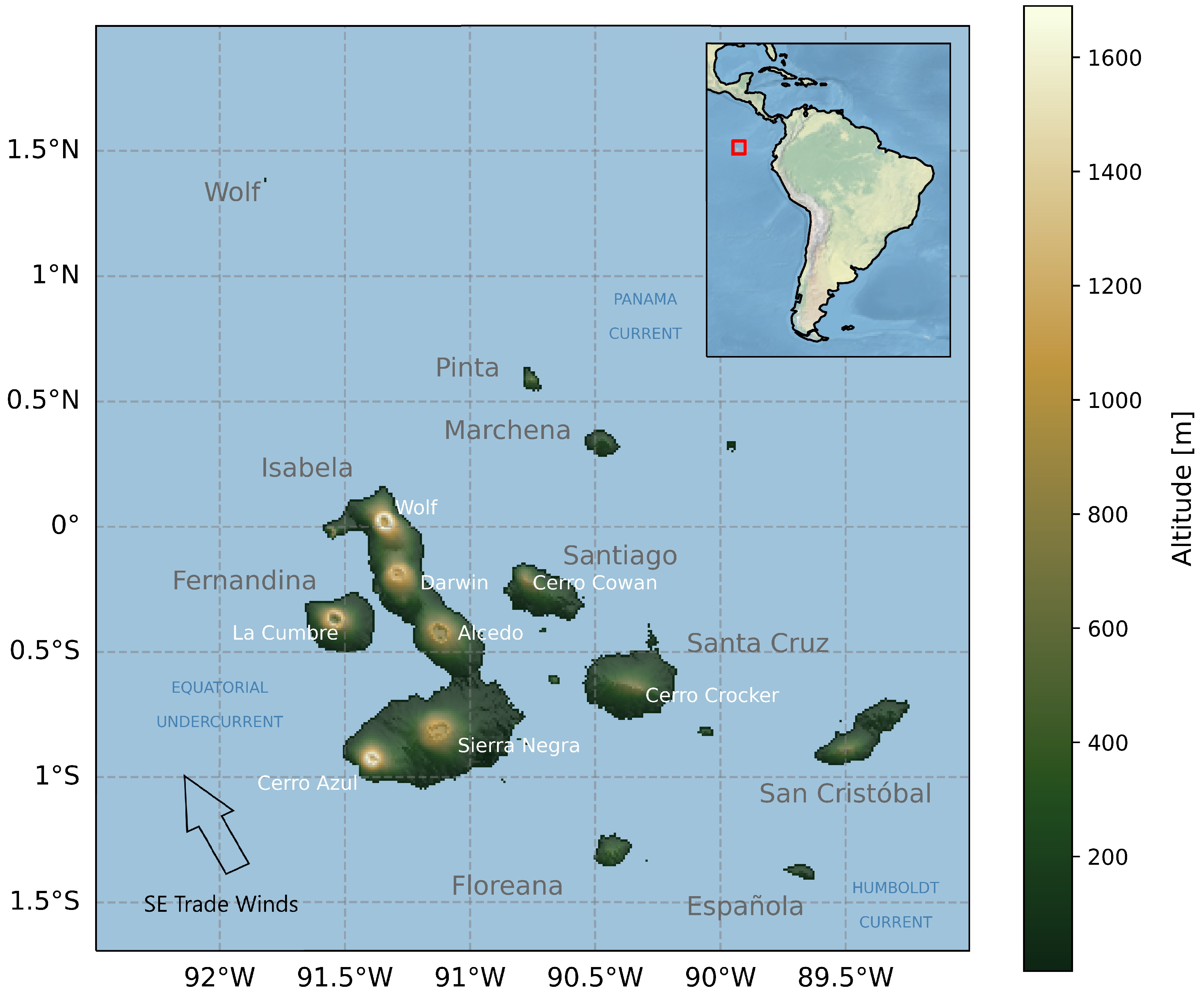

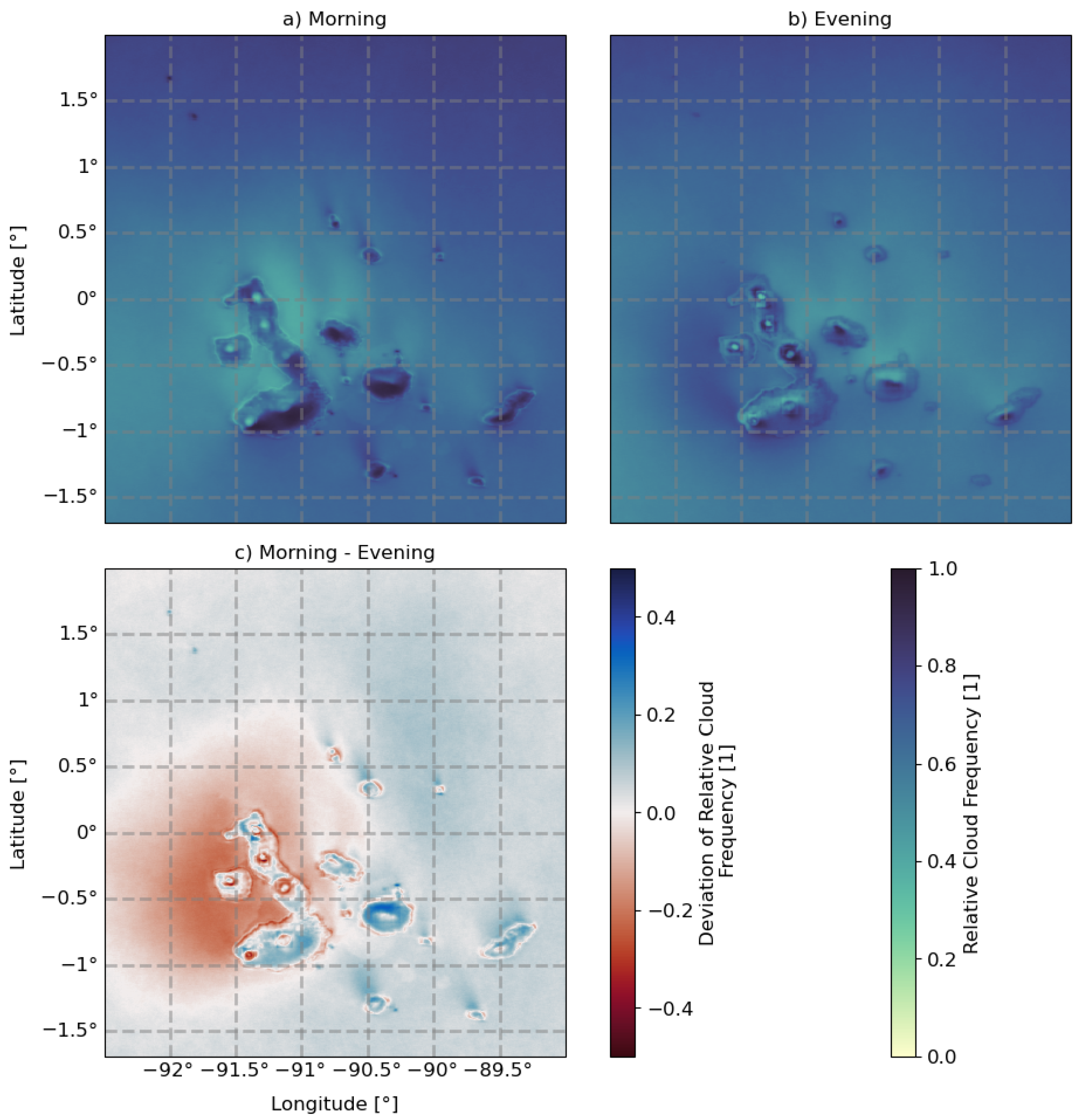
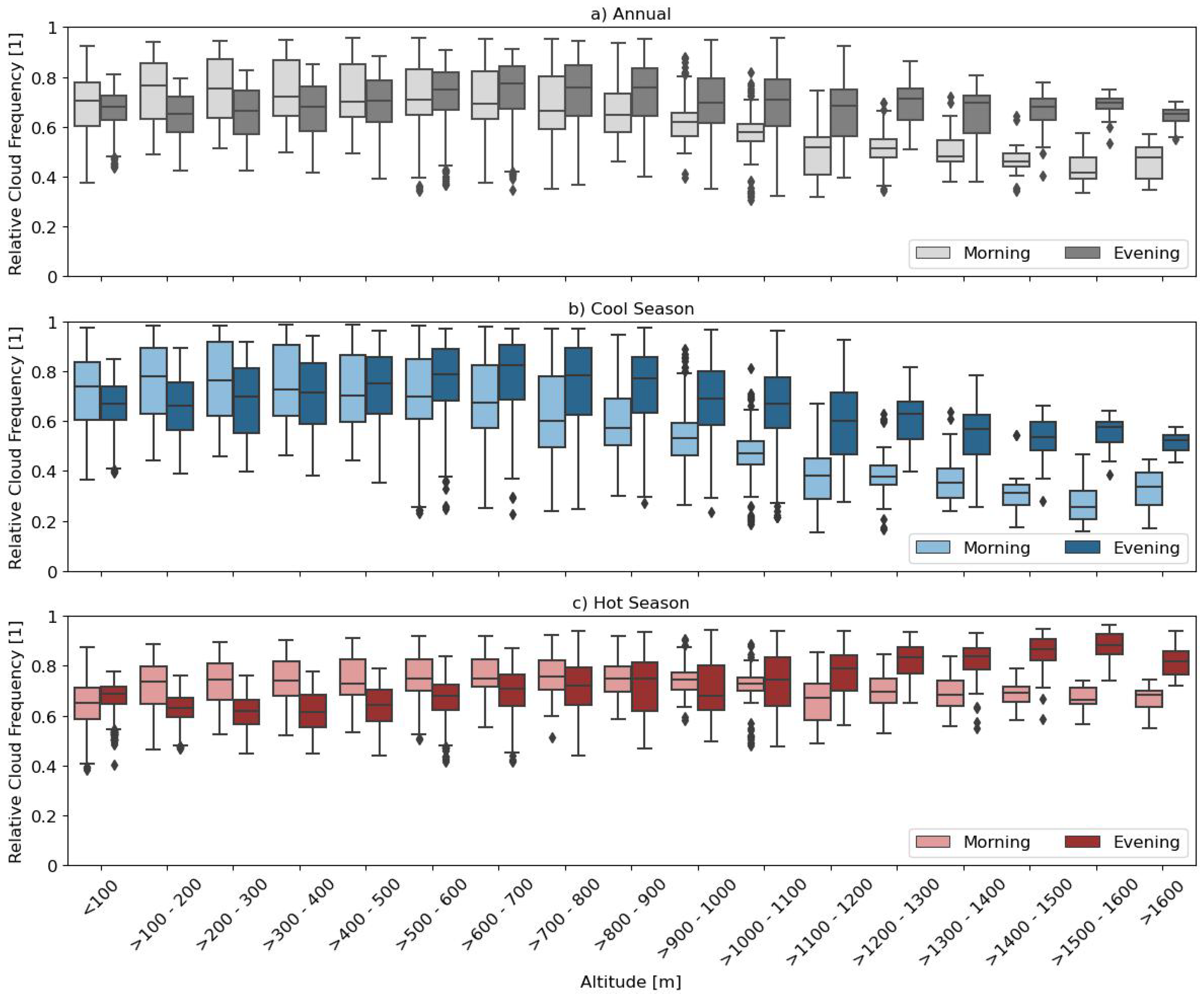
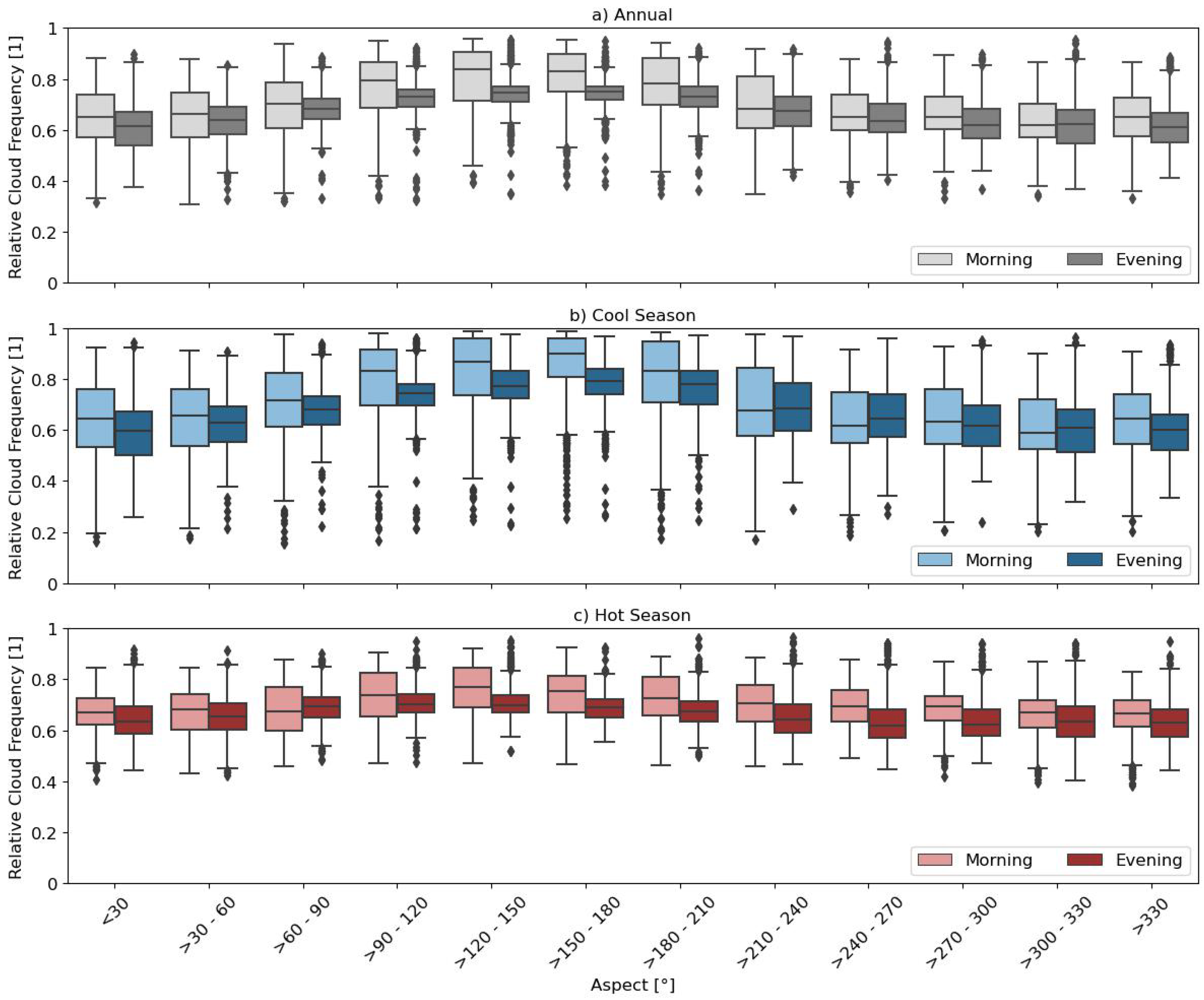
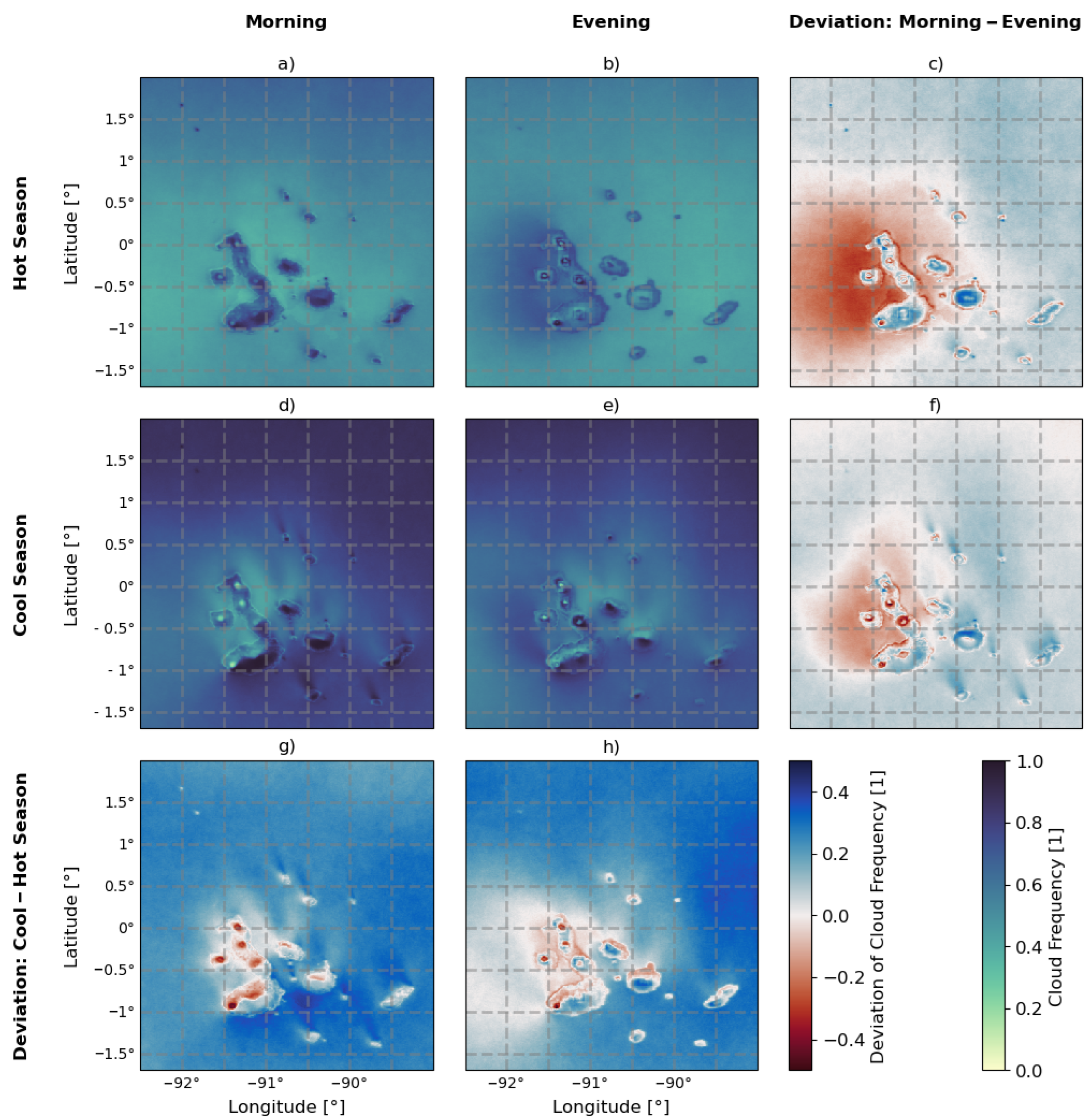
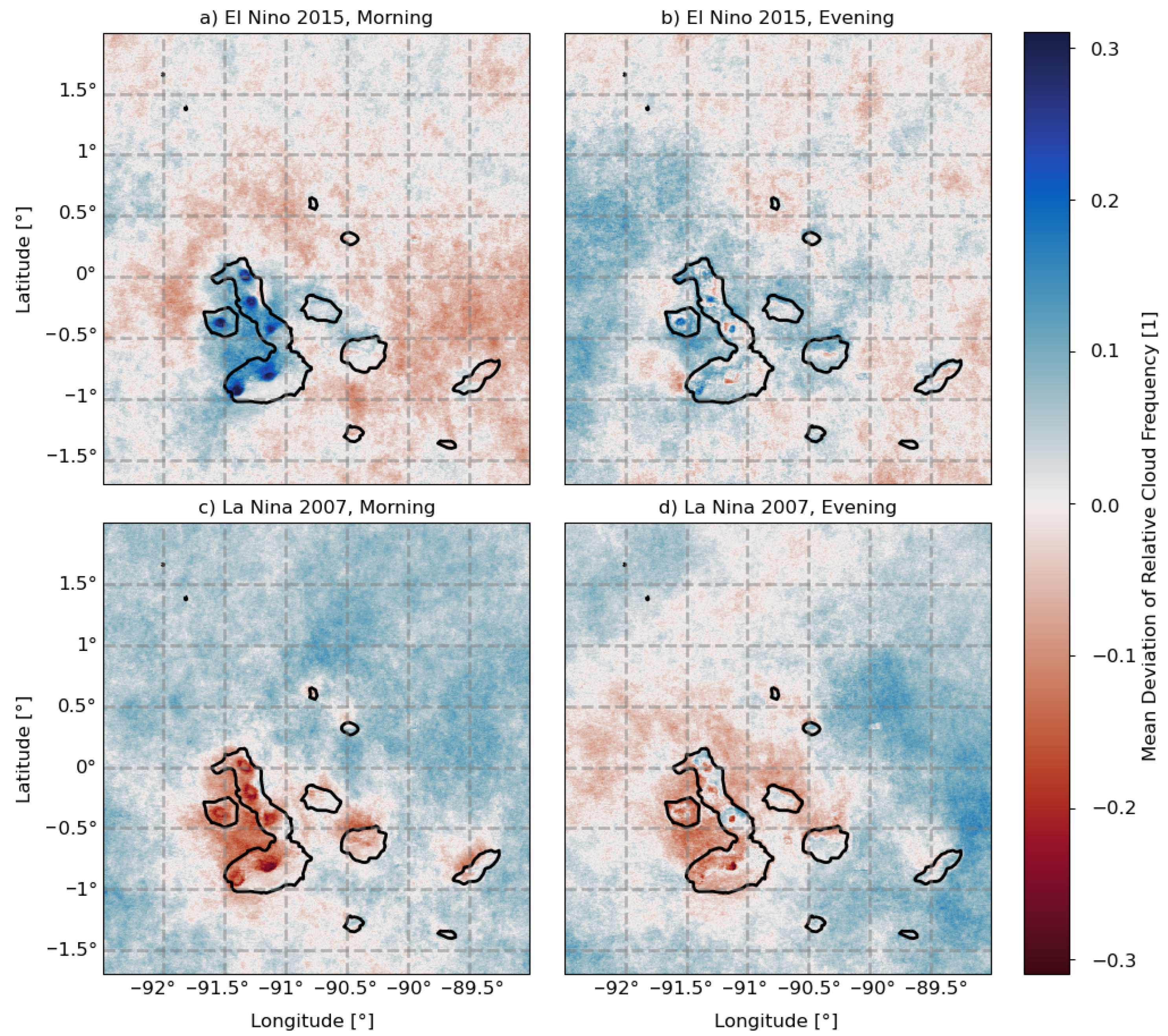
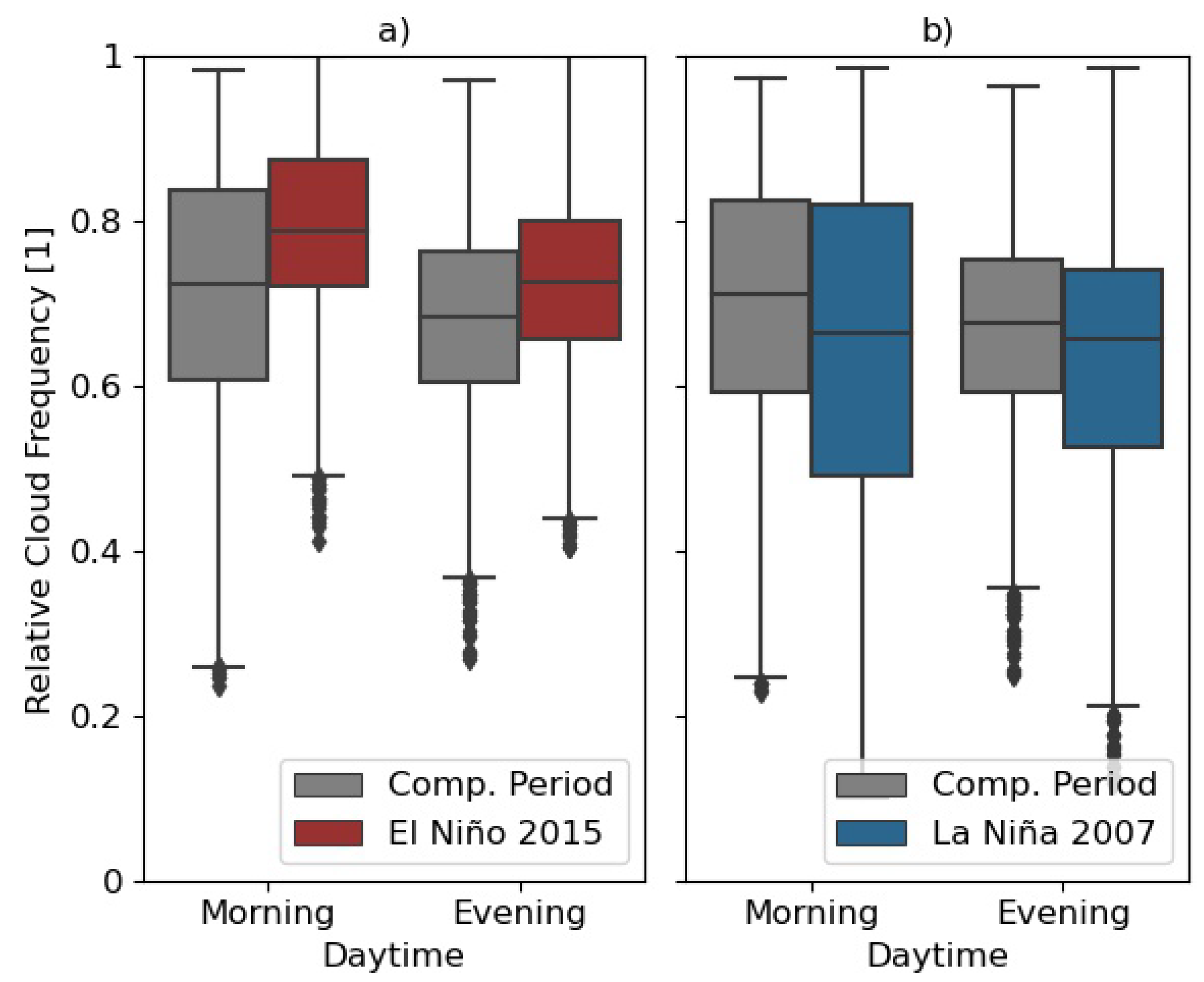
| Data Set | Formula | Value Range |
|---|---|---|
| monthly relative cloud frequency | 0: all days clear sky 1: all days clouds | |
| hot season cloud frequency | 0: all days clear sky 1: all days clouds | |
| cool season cloud frequency | 0: all days clear sky 1: all days clouds | |
| general relative cloud frequency | 0: all days clear sky 1: all days clouds | |
| deviation of extreme events | >0: more clouds during ENSO <0: less clouds during ENSO |
| Hot Season | Cool Season | |||
|---|---|---|---|---|
| Morning | Evening | Morning | Evening | |
| Altitude | 0.57 | 0.63 | 0.56 | 0.40 |
| Aspect | 0.43 | 0.37 | 0.44 | 0.60 |
Disclaimer/Publisher’s Note: The statements, opinions and data contained in all publications are solely those of the individual author(s) and contributor(s) and not of MDPI and/or the editor(s). MDPI and/or the editor(s) disclaim responsibility for any injury to people or property resulting from any ideas, methods, instructions or products referred to in the content. |
© 2023 by the authors. Licensee MDPI, Basel, Switzerland. This article is an open access article distributed under the terms and conditions of the Creative Commons Attribution (CC BY) license (https://creativecommons.org/licenses/by/4.0/).
Share and Cite
Zander, S.; Turini, N.; Ballari, D.; Bayas López, S.D.; Celleri, R.; Delgado Maldonado, B.; Orellana-Alvear, J.; Schmidt, B.; Scherer, D.; Bendix, J. The Spatio-Temporal Cloud Frequency Distribution in the Galapagos Archipelago as Seen from MODIS Cloud Mask Data. Atmosphere 2023, 14, 1225. https://doi.org/10.3390/atmos14081225
Zander S, Turini N, Ballari D, Bayas López SD, Celleri R, Delgado Maldonado B, Orellana-Alvear J, Schmidt B, Scherer D, Bendix J. The Spatio-Temporal Cloud Frequency Distribution in the Galapagos Archipelago as Seen from MODIS Cloud Mask Data. Atmosphere. 2023; 14(8):1225. https://doi.org/10.3390/atmos14081225
Chicago/Turabian StyleZander, Samira, Nazli Turini, Daniela Ballari, Steve Darwin Bayas López, Rolando Celleri, Byron Delgado Maldonado, Johanna Orellana-Alvear, Benjamin Schmidt, Dieter Scherer, and Jörg Bendix. 2023. "The Spatio-Temporal Cloud Frequency Distribution in the Galapagos Archipelago as Seen from MODIS Cloud Mask Data" Atmosphere 14, no. 8: 1225. https://doi.org/10.3390/atmos14081225
APA StyleZander, S., Turini, N., Ballari, D., Bayas López, S. D., Celleri, R., Delgado Maldonado, B., Orellana-Alvear, J., Schmidt, B., Scherer, D., & Bendix, J. (2023). The Spatio-Temporal Cloud Frequency Distribution in the Galapagos Archipelago as Seen from MODIS Cloud Mask Data. Atmosphere, 14(8), 1225. https://doi.org/10.3390/atmos14081225





